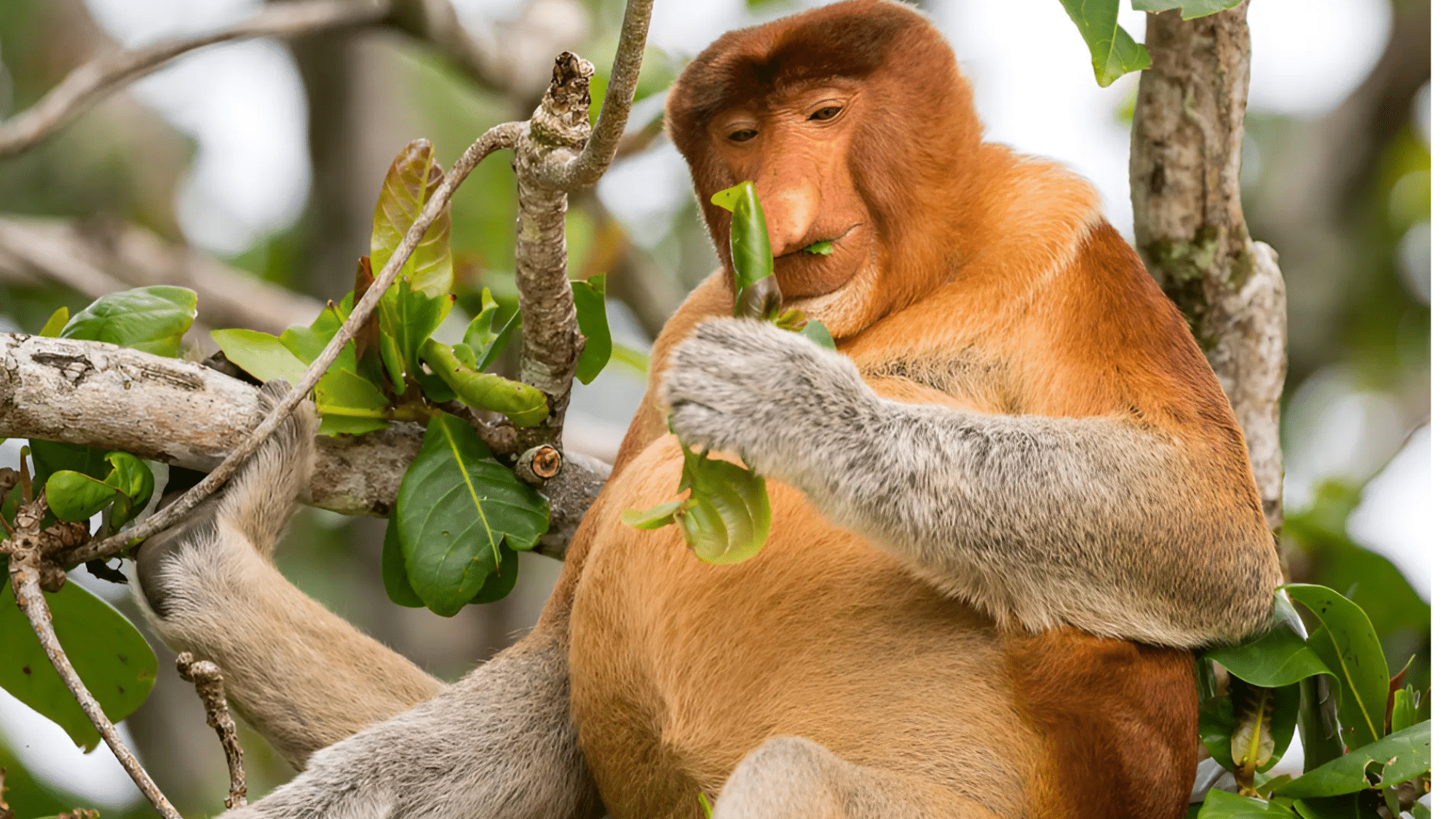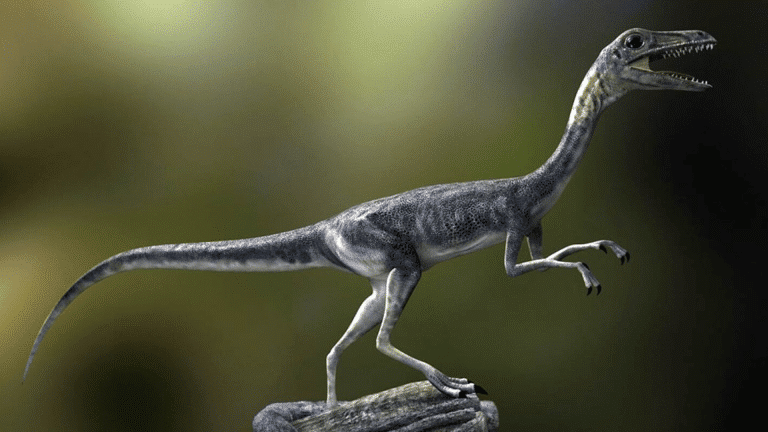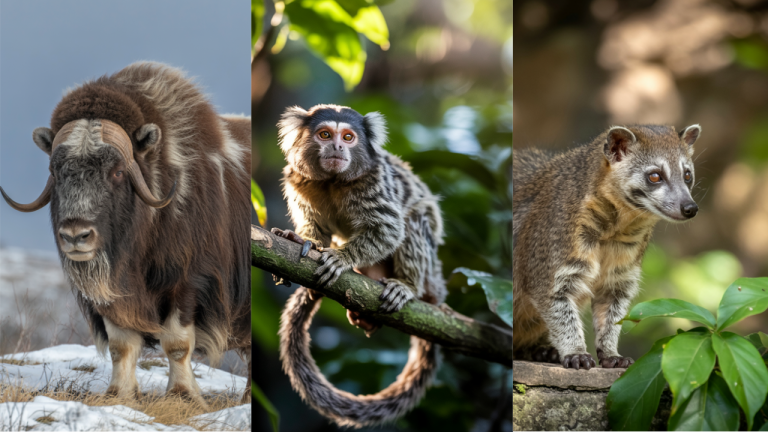With their oversized noses and potbellied bodies, proboscis monkeys are some of the most instantly recognizable animals in the primate world.
But there’s so much more to these odd-looking creatures than meets the eye. Found only in the mangroves and riverbanks of Borneo, proboscis monkeys are expert swimmers, leaf-lovers with complex stomachs, and surprisingly vocal social beings.
In this blog, we highlight the surprising facts that make them unforgettable, take a closer look at the science behind their distinct features, and review the conservation efforts aimed at saving them from extinction.
If you’re a wildlife enthusiast or simply curious about nature’s quirkiest faces, you’re in for an eye-opening experience.
What is a Proboscis Monkey?
The proboscis monkey stands out due to its long, drooping nose that can reach up to 7 inches in length. Males have significantly larger noses than females, making it easy to distinguish them from one another.
These monkeys have reddish-brown fur and round bellies. Their webbed feet help them swim well, a rare skill among primates. Males weigh 33-53 pounds, while females weigh 15-25 pounds.
Found only on Borneo in Southeast Asia, they live in mangrove forests and swampy areas near water. This habitat provides them with food and a means of escape from threats.
Their dependence on these specific environments makes them highly susceptible to any changes in their habitat.
Fun Facts About Proboscis Monkeys
If you think monkeys are all the same, the proboscis monkey will definitely change your mind! Here are five fascinating facts that reveal just how different and surprising these large-nosed primates truly are.
1. They Emit a Distinct Smell
Proboscis monkeys use specialized scent glands to produce a strong musky odor. This smell serves as a biological marker, helping them establish boundaries in the dense forests of Borneo.
The scent messages work as a silent form of communication between groups. When members of different troops come into proximity, these scents help prevent conflicts and signal social status without direct physical contact.
2. Unique Digestion
These monkeys have multi-chambered stomachs similar to cows. This special digestive system helps them break down tough leaves that other primates cannot eat.
Their stomachs contain special bacteria that break down plant toxins and extract maximum nutrition from fibrous foods. Thanks to this effective system, proboscis monkeys can thrive on a diet that would leave other monkeys hungry or sick.
They spend up to 55% of their day eating to fuel this complex digestive process.
3. Noisy Neighbors
Proboscis monkeys communicate using an array of sounds including honks, barks, and squeals. Their calls can be heard over long distances, especially at dawn and dusk.
Males make the loudest noises, with their big noses working as sound chambers that boost the volume. These calls serve various purposes: warning about predators, setting territory boundaries, and keeping the group together while moving through dense forests.
Each group develops its distinctive vocal patterns that members can identify, much like a family dialect.
4. Family Structure
They live in two types of groups: harems (one male with several females and their young) or bachelor groups (young and old males without mates).
The groups may contain 3-32 monkeys! Within harems, the dominant male defends his females from other males while the females form strong bonds with each other, often grooming and helping with childcare.
Multiple small groups often sleep in the same tree at night, forming larger communities of up to 60 individuals for safety.
Young males leave their birth groups at about 18 months old to join bachelor groups until they’re strong enough to lead their own harem.
5. Active Evenings
While most monkeys settle down at sunset, proboscis monkeys become quite active around dusk. This timing helps them avoid the hottest parts of the day while still finding enough food.
Their evening routine typically includes a feeding session, social time, and finding a safe sleeping spot near water.
This unusual schedule also helps them avoid competition with other monkey species that are active during daylight hours.
Their large eyes allow them to see well in dim light, giving them an advantage during these twilight activities.
6. Babies Are Born With Blue Faces
Baby proboscis monkeys have bright blue faces that stand out against the reddish-pink faces of adults. This color lasts about three to four months before gradually changing to adult tones, marking the baby’s development stage.
This blue coloration helps mothers quickly find their babies when multiple births happen close together.
Other monkeys also adjust their behavior based on face color—adults show more patience with blue-faced infants and become stricter as the blue fades.
7. They Leap From Trees Into Rivers
When in danger, proboscis monkeys jump from trees as high as 65 feet directly into water. They enter feet-first with their bodies positioned to reduce impact, then swim away quickly, often surfacing far from where they entered.
These jumps demonstrate their excellent awareness of water depth and their ability to select proper diving spots.
This behavior shows how completely these primates have made water part of their survival strategy, unlike most monkey species that avoid water entirely.
8. Webbed Feet Help Them Move in Water
The partial webbing between the fingers and toes of proboscis monkeys makes them excellent swimmers. This physical trait allows them to cross wide rivers and streams with surprising speed and skill.
Their swimming ability provides a key survival advantage when fleeing from snakes, clouded leopards, and other hunters.
Few other monkey species can match their comfort and skill in water, which helps explain why they thrive in swampy, riverside habitats.
9. They Only Live on One Island
Proboscis monkeys exist exclusively on Borneo, the third-largest island in the world. This limited range makes them especially important to the specific forests and mangroves of this Southeast Asian island.
Their sole presence on Borneo makes these monkeys particularly sensitive to habitat changes. As the island’s forests face pressure from logging and palm oil farming, the future of these monkeys depends largely on the success of conservation efforts in this one location.
10. Their Toes Are Extra Flexible
The unusually flexible toes of proboscis monkeys allow them to grip branches securely as they move through the forest canopy. This grip strength helps them handle thin, slippery branches even during heavy rain.
These nimble toes compensate for their bulky bodies, which would otherwise limit their movement options.
The combination of strong, flexible feet and good balance lets them access fruits and young leaves at the ends of branches where other large primates cannot go.
11. They Rarely Descend to the Ground
Proboscis monkeys spend over 95% of their lives high in the trees of Borneo’s forests. Their daily activities, eating, sleeping, social bonding, and raising young, all happen well above the forest floor.
Coming down from the trees puts these monkeys at serious risk from ground predators.
They only touch the ground when necessary, such as when crossing gaps in the forest or moving between separated feeding areas.
12. They Have Natural Predator Alarms
When a proboscis monkey spots danger, it makes a specific warning call that instantly alerts the entire group. This system works because each monkey responds without question, either by freezing, hiding, or moving away from the threat.
Different alarm calls indicate different types of threats. The group knows whether to look up for eagles, scan the water for crocodiles, or watch the ground for big cats based on the specific sound.
This complex warning system greatly increases survival rates for the whole group.
13. They Can Eat Poisonous Plants
Proboscis monkeys have stomach bacteria that break down toxic compounds found in certain plants. This digestive system lets them safely consume leaves, seeds, and fruits that would make other animals sick.
This special ability expands their food options significantly. When other food sources become scarce during dry periods, these monkeys can eat plants that other species must avoid, giving them a crucial survival edge in times of food scarcity.
14. They Practice Alloparenting
Female proboscis monkeys frequently assist in caring for babies that belong to other mothers within their social group.
This shared childcare includes cleaning the young, carrying them through difficult parts of the forest, and keeping watch while the mother feeds.
This cooperative approach to raising young benefits the entire monkey community.
Mothers get needed breaks to find food and rest, babies receive more attention and protection, and helper females gain valuable parenting skills before having their own offspring.
Why Do Proboscis Monkeys Have Big Noses?
The large nose of the male proboscis monkey serves four key purposes:
Attraction
Females prefer males with bigger noses. Males with larger noses typically attract more females and maintain larger groups. This makes the nose a key factor in mating success.
Sound Enhancement
The nose acts as a sound chamber that makes male calls louder. This helps them warn their group of danger and mark their territory without physical fights.
Cooling System
The large, blood-rich nose likely helps cool blood going to the brain. This natural cooling system helps them cope with the hot forest climate.
Quick Identification
The distinctive nose shape allows fast recognition of their own species in mixed-species areas, helping them find potential mates and group members.
Conservation Status of Proboscis Monkeys
The big-nosed primates of Borneo are endangered, with only 7,000 to 15,000 individuals remaining in the wild. Their population has declined by 50% over the past 40 years across Malaysia, Indonesia, and Brunei.
Forest loss from palm oil plantations, housing development, and timber harvesting poses the main threat to their survival.
These primates need specific river forest habitats, making them vulnerable to destruction. Water pollution and hunting create additional pressures.
Protected wildlife areas in Kinabatangan and Tanjung Puting offer some protection, while tourism provides income for local communities.
However, proboscis monkeys could disappear within decades without proper forest protection measures.
Conclusion
Proboscis monkeys are more than just unusual-looking animals; they’re smart, social, and perfectly adapted to their environment.
Their physical traits and behaviors are specifically suited to Borneo’s riverside forests. However, these specific needs make them especially at risk when their habitat changes.
You can help by learning about them, sharing information with others, and supporting groups that protect rainforests. Small efforts add up to make a difference.
If this article taught you something new about these monkeys, pass it along to someone else who might find it interesting.
Have you seen proboscis monkeys in videos or during travels? Share your experience in the comments section below.
Want to explore more fascinating monkey species and their wild traits? Check out our full guide on Monkeys: Various Types, Unique Traits, and Habitats for a deeper look into the primate world.























